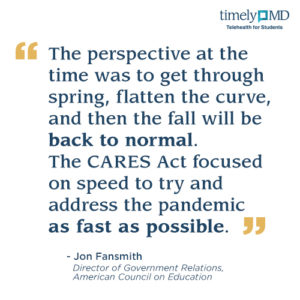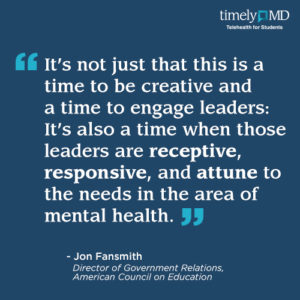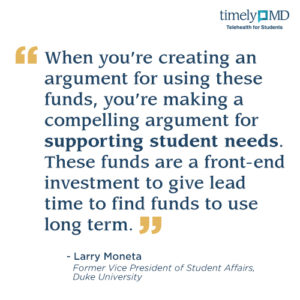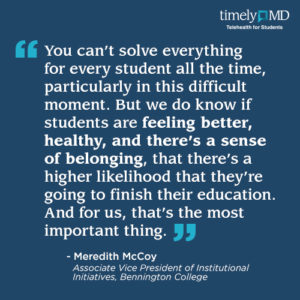Table of Contents
Since the beginning of the COVID-19 pandemic, higher education has experienced a wave of unexpected challenges. From campus closures and remote learning to COVID-19 testing and quarantines, 2020 looked nothing like higher education had planned. As the learning environment changed, some students decided to make alternative plans, with some dropping out, taking gap years, or changing schools. This resulted in decreased enrollment, budget cuts, and significant revenue loss. To help offset the impact of the COVID-19 pandemic, Congress passed a series of emergency aid packages, with a significant amount of funds for higher education. Now, schools must navigate how to access these higher education stimulus funds, disperse aid to college students, and launch programs that will support students both now and in the future.
What emergency funds are available to higher education?
 In the webinar Stimulus Funding: A Lifeline for Student Well-Being, Jon Fansmith, director of government relations for the American Council on Education (ACE), provided information about all three of the laws that, to date, have provided just under $77 billion for higher education. The primary source of this money is the Higher Education Emergency Relief Fund (HEERF), split between institutions and students.
In the webinar Stimulus Funding: A Lifeline for Student Well-Being, Jon Fansmith, director of government relations for the American Council on Education (ACE), provided information about all three of the laws that, to date, have provided just under $77 billion for higher education. The primary source of this money is the Higher Education Emergency Relief Fund (HEERF), split between institutions and students.
For a more in-depth look, the National Association of Student Financial Aid Administrators (NASFAA) created a comparison of the three laws.
Click here for an overview of each Higher Education Emergency Relief Fund (HEERF) from NASFAA.
HEERF I – The Coronavirus Aid, Relief, and Economic Security Act (CARES Act)
President Trump declared a national emergency due to the COVID-19 pandemic on March 13, 2020, which President Biden recently extended. Two weeks later, the CARES Act was passed on March 27, 2020. The means of dispersing funds was unusual for a government program, with money sent directly to institutions. Then the institutions were responsible for managing money and dispersing it to students.
“The perspective at the time was to get through spring, flatten the curve, and then the fall will be back to normal,” said Fansmith. “The CARES Act focused on speed to try and address the pandemic as fast as possible.”
The details:
The law provided $14 billion in relief for higher education.
Minority-serving institutions received $1 billion.
Funds were split evenly, with $6.3 billion for institutions and $6.3 billion for college students.
Colleges most severely impacted by COVID-19 received $350 million.
HEERF II – The Coronavirus Response and Relief Supplemental Appropriations Act (CRRSA Act)
A nine-month gap followed the CARES Act. That initial round of relief funding met urgent needs, but higher education institutions needed to meet the holistic needs of college students. The CRRSA Act was signed into law on December 27, 2020. With this relief package, the government looked to help schools and students with funding that was more flexible to address the long-term impacts of the pandemic.
The details:
The law provided $23 billion in relief for higher education.
Minority-serving institutions received $1.7 billion.
For-profit institutions received $681 million that could only be used on student grants.
There was a shift in funds to as much as $14.4 billion for institutions and at least $6.3 billion for college students.
Institutions with the greatest unmet need related to the pandemic received $113.5 million.
HEERF III – The American Rescue Plan (ARP)
President Biden signed the ARP into law on March 11, 2021. As part of this latest relief bill, the ARP continued to support colleges and universities and their students. According to NASFAA, “The American Rescue Plan (ARP) included additional COVID-19 relief for institutions of higher education. This new COVID stimulus bill included $40 billion, available through September 30, 2023, for higher education institutions and students, using the same Higher Education Emergency Relief Fund (HEERF) model established in the Coronavirus Aid, Relief and Economic Security (CARES) Act.”
The details:
The law provided $40 billion in relief for higher education
Minority-serving institutions received an additional $3 billion.
For-profit institutions received $396 million that could only be used on student grants
Public and private non-profit institutions received $36 billion.
Institutions with the greatest unmet need related to the pandemic received $198 million.
The purpose of the emergency funds
It might seem obvious what these bills were designed to do—provide relief. But it was less obvious at first exactly how schools were allowed to use these higher education stimulus funds for institutional purposes and to support students.
The U.S. Department of Education defined that at least 50% of the CARES Act funds that were allocated to an institution must be reserved to provide students with emergency financial aid grants to help cover expenses related to the disruption of campus operations due to COVID-19.
Almost all students are eligible for aid. Initially, the Department of Education determined that only students eligible for financial aid through the Free Application for Federal Student Aid (FAFSA) were eligible to receive this emergency aid. When the CRRSA Act passed, the Trump administration retracted that eligibility requirement to open aid to any student. However, there are exceptions that prohibit aid for undocumented and international students. Across all three bills, higher education institutions are only required to prioritize students with exceptional needs in determining how the aid is allocated to students.
Guidance from NASFAA states that financial aid grants for students may be used for any component of the student’s cost of attendance or for emergency costs that arise due to coronavirus, such as tuition, food, housing, health care (including mental health care), or child care.
How emergency funds can be allocated within the institution
The CARES Act initially defined that the institutional funds included in the relief bill be used to cover any costs associated with significant changes to the delivery of instruction due to COVID-19 and/or for additional emergency financial aid grants, subject to certain limitations.
However, the CRRSA Act expands the flexibility of those funds to include:
- Defraying expenses associated with COVID-19 (including lost revenue, reimbursement for expenses already incurred, technology costs associated with a transition to distance education, faculty and staff training, and payroll);
- Carrying out student support activities authorized by the Higher Education Act of 1965, as amended (HEA), that address needs related to COVID-19; and
- Making additional financial aid grants to students.
The focus of the CARES Act was the initial impact of COVID-19, but the CRRSA Act expanded the range of uses to include institutional losses of revenue and costs incurred due to the pandemic. The Department of Education will announce soon the details on how institutional funds from the ARP can be used. Fansmith said that this round of funding should look very similar to the current rules, but there may be additional information to help higher education institutions understand what programs and initiatives the funds can help launch to benefit students.
Discover how telehealth improves campus health
Did your institution receive emergency aid from the stimulus bills?
Nearly all schools receive emergency aid under these relief bills, according to Fansmith. There are some exceptions, but if your institution received funds under the CARES Act, then your school will also receive funds from the CRRSA Act and ARP.
To receive emergency aid, institutions must sign and return the Certificate of Funding and Agreement to acknowledge the terms and conditions of the funding. If an institution completed this already for CARES funds, it does not need to do so for subsequent rounds of funding.
Fansmith noted exceptions to receiving funds that include:
- For-profit institutions were treated differently under the CARES Act. Limits were put on relief funds and for what they could be used.
- If your school’s report on the allocation of CARES Act funds was not filed, then there will be a delay in receiving the second and third rounds of aid.
- A small group of schools subject to the so-called “endowment tax ” only received CRRSA funds for students, but not the institutional share. These schools were treated the same as other schools to determine their CARES and ARPA funds.
Additional requirements to be aware of:
- Institutions have one year from the date of grant notification to use relief funds.
- Funds can be drawn throughout the year.
- Student funds that are drawn down must be dispersed within 15 days.
- Institutional funds that are drawn down must be dispersed within three days.
- Some circumstances allow a one-year extension on the use of funds.
How to support students with stimulus funds
 In TimelyCare’s webinar, a panel of higher ed experts shared their experiences in navigating the last year, allocation of relief funds, and supporting students. Larry Moneta, former vice president of student affairs at Duke University, spoke about the unique opportunity that higher education has and the pressure that schools are under to respond and help students with real-life concerns.
In TimelyCare’s webinar, a panel of higher ed experts shared their experiences in navigating the last year, allocation of relief funds, and supporting students. Larry Moneta, former vice president of student affairs at Duke University, spoke about the unique opportunity that higher education has and the pressure that schools are under to respond and help students with real-life concerns.
Issues like food and housing insecurity have become significant issues for students. Additionally, the negative impact of the pandemic on mental health cannot be overstated. One year into COVID-19, a survey by TimelyCare found that four out of five college students say they continue to experience increased stress and/or anxiety.
Fansmith noted that ACE has surveyed college and university presidents every month since the pandemic began. When asked about their top concerns, presidents have consistently said their number one concern is student mental health (72%), and their second-highest concern in the previous two surveys is staff mental health (58%).
“It’s not just that this is a time to be creative and a time to engage leaders: It’s also a time when those leaders are receptive, responsive, and attune to the needs in the area of mental health,” said Fansmith. “Certainly, presidents were very concerned about it before the pandemic. And the pandemic has only made it a more significant concern on campus.”
 Regardless of how institutions choose to use stimulus funds, Moneta emphasized the importance of organizing quickly to understand:
Regardless of how institutions choose to use stimulus funds, Moneta emphasized the importance of organizing quickly to understand:
- What are the unmet needs of students that relief funds could support?
- What is the case for starting a program to meet students’ needs?
- Who is the point person within the institution to receive funds?
- Who are the institutional decision-makers on how funds are dispersed?
- How can the institution ensure the long-term sustainability of new programs and initiatives supported by stimulus funds?
“When you’re creating an argument for using these funds, you’re making a compelling argument for supporting student needs,” said Moneta. “These funds are a front-end investment to give lead time to find funds to use long term.”
Meeting the mental health need of Bennington College students with stimulus funds
For Meredith McCoy, associate vice president of institutional initiatives at Bennington College, the biggest challenge when it came to higher education stimulus funds was quickly understanding the details of using the emergency aid and moving forward. When the stimulus funds became available, McCoy said some of it was easily understandable, like covering lost revenue and identifying students with extraordinary needs. However, the more complicated part was how to be responsive to support students in the moment.
“The mental health needs of our students are always a priority,” said McCoy. “Then we added in remote, hybrid, and international students as we tried to start an academic year. We had to make sure everyone was covered in a way that feels safe and secure to allow them to do their job as a student. That went from difficult to feeling impossible.”
The school tried to piece together health and well-being support on its own as the pandemic began. And the complications of working with a student population in different states and countries went from a “trickle of resources and time to a flood pretty quickly,” said McCoy.
“We were fortunate to take a moment to identify our priorities,” said McCoy. “For us, the priorities were looking ahead to what is a sustainable, long-term solution that will adapt with our students regardless of what breaks in the world.
“If we learned anything from the pandemic, it’s that everything is unpredictable. We have to be ready to be more flexible and more adaptive. As our student population has increased with international students, we have to make sure that their health and wellness needs are taken care of regardless of time, date, or place.”
 After identifying this priority and need, leaders at Bennington College began to research telehealth options for college students. After initial concerns from the college’s board of directors on spending for more student services, leaders at the institution used the opportunity provided by the stimulus funds to think about how to offset the start-up costs of a platform like TimelyCare so that there is no perceived loss. With a forward-thinking plan to slowly build a student health fee, telehealth became a long-term, sustainable solution that ultimately allows the college to provide telehealth at no additional cost to the university.
After identifying this priority and need, leaders at Bennington College began to research telehealth options for college students. After initial concerns from the college’s board of directors on spending for more student services, leaders at the institution used the opportunity provided by the stimulus funds to think about how to offset the start-up costs of a platform like TimelyCare so that there is no perceived loss. With a forward-thinking plan to slowly build a student health fee, telehealth became a long-term, sustainable solution that ultimately allows the college to provide telehealth at no additional cost to the university.
“You can’t solve everything for every student all the time, particularly in this difficult moment,” said McCoy. “But we do know if students are feeling better, healthy, and there’s a sense of belonging, that there’s a higher likelihood that they’re going to finish their education. And for us, that’s the most important thing.”
What’s next for higher education aid and funding?
In January 2022, an additional $198 million in American Rescue Plan funds were released to support community colleges and other institutions to meet students’ basic needs such as housing and food security. More recently, the U.S. Department of Education announced that historically Black colleges and universities (HBCUs) can apply for grants as part of the Project School Emergency Response to Violence program (Project SERV), after these institutions were the target of dozens of bomb threats.
President Biden’s latest budget proposal includes $2,175 increase in the maximum Pell Grant that would bring the maximum annual Pell award to $8,670. The proposal also include increases for programs at HBCUs and other minority-serving institutions.
As higher education continues to recover from the pandemic, relief funds offer a unique opportunity for schools to support students with direct financial aid and programs that can provide much-needed student resources. As your school analyzes how best to utilize these funds, be sure to listen to what students say they need. Also, strategically look forward to how the programs you initiate can become long-term, sustainable parts of your institution’s plan to ensure that students are healthy, retained, and will graduate.
For additional guidance from higher education experts, watch the webinar, Stimulus Funding: A Lifeline for Student Well-Being. To find out how higher education stimulus funds can help create a sustainable telehealth program that supports the mental health of your students, contact TimelyCare.






